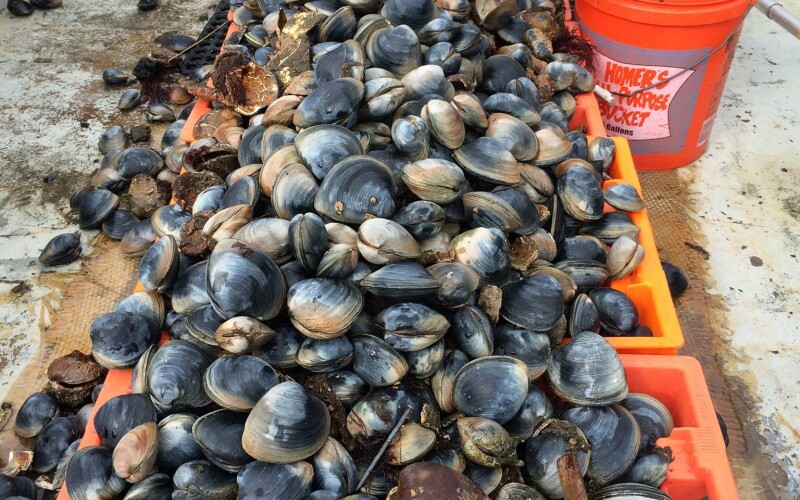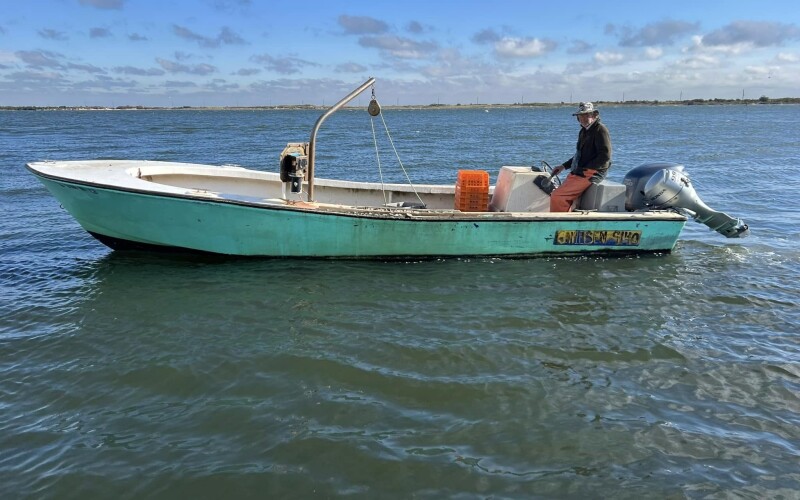A valuable clam fishery carries on in northern New Jersey bay waters
Most of those clammers sell to James T. White Clam Depuration Plant, in Highlands, N.J. The depuration plant, which is owned by the Borough of Highlands, and leased to the Baymen’s Protective Association, is named after the former Highlands mayor, James T. White, who got the plant back up and running in 1989. The Clean Water Clam Company, operating as United Seacoast Clams, is a privately owned depuration plant and wholesaler in nearby Sea Bright, N.J., with other clammers also working the waters of Raritan and Sandy Hook Bays.

“The Baymen’s Protective Association controls J.T. White,” says Jenks, whose roots in the Northeast go back to the 1600s. “There are about 70 full time guys, or I should say, boats, because they usually have a helper.” As Jenks describes it, the plant can handle 240 baskets a day, each of which holds about a bushel, or 50 pounds of clams. “It depends on how many guys show up, then they divide the baskets evenly between them, usually you get about six. If some guys don’t fill all their baskets, those are called “voids” and they give them to someone else to fill.”
According to Jenks, the clammers use rakes about two to three feet wide with a row of 3-inch teeth and a basket to catch the clams. “It has a telescoping handle that can extend about fifty feet, though they like to work in 20 to 25 feet,” he says. “They drift along and kind of jerk the rake to get the mud out, and they can feel when they’re getting clams.”

The head of the rake usually has a line attached to it, and after anywhere from five to fifteen minutes of raking, the clammers use a rope tied to the head to bring it aboard. “The measure for a legal clam is 1-1/2-inches length,” says Jenks. “The culls go back.”
The clammers don’t get paid by the pound or the basket though; they get paid by the clam. “A lot of guys count them” says Jenks. “If you count 5,650, and the plant says you had 4,650, you know something’s wrong. What I used to do was count one basket and multiply by the number of baskets.”

The relationship between the New Jersey clammers and the plant has seen ups and downs. “Some of us formed the SHARC, the Sandy Hook Alliance of Real Clammers, to confront what they saw as corruption and infighting in the BPA (Baymen’s Protective Association),” says Jenks. “Two guys I still go out with sometimes are “Eagle” John O’Brian, and Gerald “Riddler” Nielsen.”

Nielsen, the “Riddler,” who identifies on Facebook as a “bivalve extraction engineer,” has earned his name. “I was mad at the guy who gave me that name,” he says. “But when I thought about it, I guess I should thank him. I told him he had a great face for radio. It took him a few days to realize it wasn’t a compliment, and so after that he called me the “Riddler,” referring to the villain in the old Batman comic strips.
Like many of the guys handling the long rakes, Nielsen is tall at 6’ 4”. He started clamming near his home on Long Island at age 17. “I grew up in Sayville, Long Island, home of some of the best clamdiggers I will ever know,” he says. While studying economics at Haverford College, near Philadelphia, Nielsen continued to race home on weekends to make a couple of hundred dollars clamming. After earning a masters degree in economics, he tried to get a job on Wall Street. “They told me I looked too young. It might have saved me.” He went back to clamming and that’s what he was doing on 9/11 when he recalls that he lost a few of his best friends in the World Trade Center.
At age 63, Nielsen now runs a 24-foot skiff painted “Riddler green,” the trademark color of its Batman namesake, with a 225-hp Honda four-stroke. “I’m impressed with the four-stroke,” he says. “You get 5,000 hours out of them instead of 500 on a 90-hp two-stroke. The one I have now has 9,000 hours on it.”

Nielsen bought the skiff 24 years ago, took it down to the shell and rebuilt it from stem to stern. “I put in new stringers, new bulkheads, and new decks. I’m glad I put the decks in because Hurricane Sandy hit the next year and I ended up with a cabin cruiser on top of my boat. But all it did was crack the rail a little.”
Heading out early, Nielsen typically spends about five hours clamming. “Sometimes you stay out waiting around to see if they (the processors) give you more baskets,” he says. With 46 years of experience under his belt, he has a good touch with the rake. “You can feel it,” he says of the clams filling the rake. “Sometimes you get a good grab. The best I ever had was eighty in a grab. I looked all over but couldn’t find that spot again. It ended up being an average day.”
Among the challenges he faces – the weather, fishery politics, and being followed around by other clammers – Nielsen is seeing the limits tighten up due to aquaculture. “They grow them on their leases, they’re the same as ours, a littleneck is a littleneck. It’s not like we’re selling oysters that are like a wine, where there’s differences. The limits kind of take the fun out of it.”
Regardless of the changes, Riddler doesn’t seem likely to give up being a bivalve extraction engineer. The clammers of Raritan Bay have endured, like the Jenks family, since the 1600s, and there’s something reassuring in knowing the Eagle, the Riddler and the rest of the clammers are still there.








